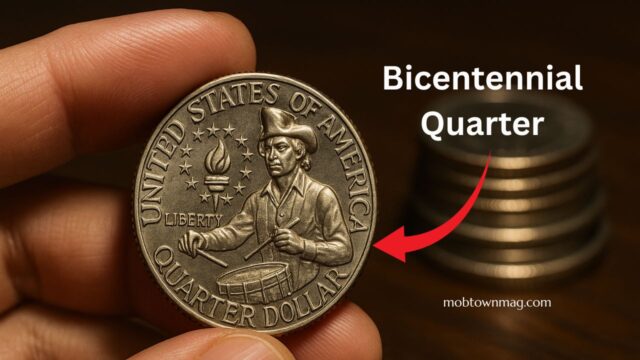The Bicentennial quarter, minted in 1975 and 1976 to celebrate America’s 200th birthday, has become one of the most talked-about U.S. coins in recent years.
Lately, rumors about a $4.4 billion “Drummer Boy” quarter have flooded social media, sparking excitement among casual change-checkers and collectors alike.
But is there any truth to this jaw-dropping claim? While the billion-dollar story is nothing more than internet hype, certain Bicentennial quarters can fetch impressive sums—especially rare silver issues, top-grade examples, and certified error varieties.
A recent viral claim has taken social media by storm: someone says there’s a Bicentennial quarter (1976, marked “1776–1976” with the Drummer Boy on the reverse) worth an astounding $4.4 billion. But how much truth is there to this staggering figure? In short: none.
The claim is purely mythic, the product of sensational headlines. However, that doesn’t mean some Bicentennial quarters aren’t legitimately valuable—if and when they meet very specific, rare criteria.
In this guide, we’ll explore the facts, break down realistic values, and show you how to identify a truly valuable coin hiding in your pocket change.
What Is a Bicentennial Quarter?
The Bicentennial quarter was issued in 1975–1976 to celebrate America’s 200th anniversary. Its reverse features Jack Ahr’s iconic Drummer Boy design paired with dual dates (1776–1976).
These coins were minted in Philadelphia and Denver (copper-nickel clad) and in San Francisco, where both silver struck versions and proof sets were offered.
Most of these quarters are extremely common, minted in the hundreds of millions, and worth just face value—25¢—in everyday circulation.
Why the “$4.4 Billion” Claim Is Completely False
- There is absolutely no record of any Bicentennial quarter ever selling—or even being priced—at anywhere near $4.4 billion.
- Even the most pristine examples command thousands, not billions.
- The claim appears to stem from internet clickbait, deliberately exaggerated for shock value. In reality, the numismatic market relies on actual auction records and grading verification, none of which support such an astronomical figure.
When Is a Bicentennial Quarter Truly Valuable?
Here are the realistic categories where such quarters have real-world, documented value:
A. Top-Graded Clad Strikes (MS67–MS68)
- These coins, exceptionally preserved with few or no contact marks and strong luster, occasionally sell for low thousands of dollars, depending on the grade.
B. San Francisco 40% Silver Issues
- Regular strikes and especially proofs in MS68–MS69 or PR68–PR69 Deep Cameo grades can fetch several thousand dollars, primarily due to silver content and collector interest.
C. Certified Error Coins or Varieties
- A notable example is the 1976-D Doubled Die Obverse (DDO), where noticeable doubling appears on “LIBERTY,” “IN GOD WE TRUST,” or the date.
- Professionally graded examples of such errors can earn strong premiums—sometimes into the mid-five-figure range for the absolute rarest, top-grade pieces.
Quick Reference
| Coin Type | Mint & Composition | Estimated Mintage | Typical Value in Circulation | High-End Auction Value (Top Grade/Error) |
|---|---|---|---|---|
| Clad Quarter (Philadelphia) | Copper-nickel | ~800 million | $0.25 | ~$2,000–$5,000 (MS67–68) |
| Clad Quarter (Denver, D) | Copper-nickel | ~860 million | $0.25 | ~$2,500–$6,000 (MS68) |
| Silver Quarter (San Francisco) | 40% silver (regular strike) | ~11 million | Slight premium over face | ~$7,000–$15,000 (MS68–69) |
| Proof Silver Quarter (SF, Proof) | 40% silver (proof set) | ~4 million | Collector premium | ~$5,000–$12,000 (PR68–PR69 Deep Cameo) |
| 1976-D Doubled Die Obverse (DDO) | Clad (Denver error variety) | Very few known | — | Rare: low to mid five figures |
How to Identify Something That Could Be Valuable
- Check the edge: Silver versions have a uniform gray edge, while clad coins display a copper-colored stripe along the rim.
- Look for the mint mark:
- None = Philadelphia (clad)
- D = Denver (clad)
- S = San Francisco (silver issues and proofs)
- Evaluate condition carefully: Compare to known high-grade examples; look for preserved luster, sharp details, and minimal handling marks.
- Spot potential errors/varieties: Doubling on the obverse inscriptions or striking anomalies can make a difference—but only if verified by a respected grading service.
- Get it graded: Any coin suspected to be valuable—especially potential top-grade or error examples—should go to a trusted third-party grade service for authentication and certification.
If you stumbled across rumors about a $4.4 billion Bicentennial quarter, rest easy: it’s pure fiction. But don’t toss your 1976 Drummer Boy quarters just yet! A small subset—namely top-grade clad pieces, 40% silver issues, and authenticated error varieties—can hold significant value.
The key is condition, documentation, and proper grading. Trust the verified auction records, not sensational headlines, to determine what your quarter may be worth.
FAQs
Is any Bicentennial quarter worth $4.4 billion?
No. That figure is entirely fictional. No coin sale or verified valuation has ever approached anywhere near that amount.
What kind of Bicentennial quarter could be valuable?
High-value examples include top-graded clad coins (MS67–MS68), San Francisco 40% silver issues (especially in MS68–MS69 or PR68–PR69 Deep Cameo), and verified error/variety coins like the 1976-D DDO.
How do I confirm if my quarter is worth something?
Check for mint mark and edge coloration (to spot silver issues), assess the condition, and if you suspect it’s rare or valuable, submit it to a reputable grading service. Auction catalogs and price guides (based on real sales) will give you a clear idea of value—not social media hype.
